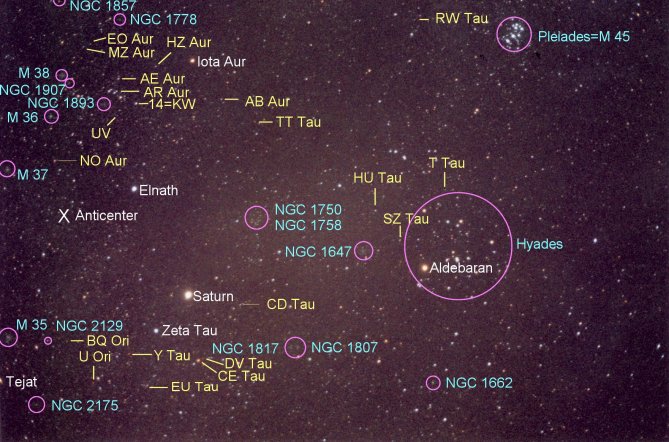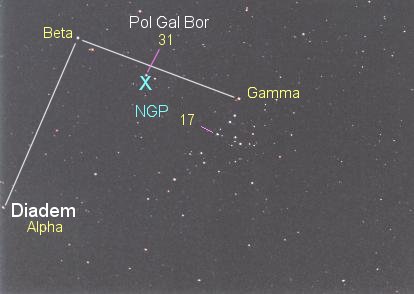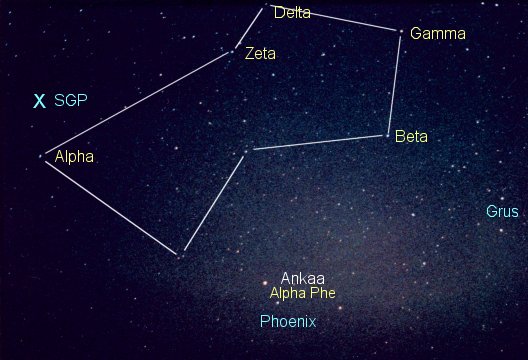Milky Way out
-
oh_wellian
- Asternaut
- Posts: 4
- Joined: Wed Apr 20, 2011 10:46 pm
Milky Way out
I know that the "path" to the galatic core is through Sagittarius. That said,
1. Which constellation(s) are the other way, opposite the galatic core?
2. And, once peering at this constellation(s), am I looking into interstellar space? Or is there another Milky Way arm(s) that I cannot see?
1. Which constellation(s) are the other way, opposite the galatic core?
2. And, once peering at this constellation(s), am I looking into interstellar space? Or is there another Milky Way arm(s) that I cannot see?
- rstevenson
- Quis custodiet ipsos custodes?
- Posts: 2705
- Joined: Fri Mar 28, 2008 1:24 pm
- Location: Halifax, NS, Canada
Re: Milky Way out
The Wikipedia article on the Milky Way contains a lot of information about our home. Scroll down the page about 1/3 of the way to three "overhead" views of the Milky Way. They show that there is one more arm, the Perseus Arm outside of our home arm.
My astronomy software tells me that you'd be facing more or less in the direction of Orion or Gemini if you turned your back to Sagittarius. (I can't go out and look -- it's raining, and anyway Sagittarius is below my horizon at the moment.)
Rob
My astronomy software tells me that you'd be facing more or less in the direction of Orion or Gemini if you turned your back to Sagittarius. (I can't go out and look -- it's raining, and anyway Sagittarius is below my horizon at the moment.)
Rob
Re: Milky Way out
The Galactic Anticenter of the Milky Way is roughly RA 05h 46m, Dec. +28° 56', about 5° east of El Nath of Auriga.
In practice, however, that falls right in the middle of Coma Berenices (just east of the Coma cluster), which still has a lot of stars in it. Galactic south seems to have fewer.
The key to finding interstellar space is simply to avoid looking at stars--that's what allows Hubble to make its Deep Field images.
Sam
However, since the Milky Way is a very thin disc, one would theoretically have better luck looking into deep intergalactic space when looking towards galactic north, defined as RA 12h 49m, declination +27.4°.http://stars.astro.illinois.edu/sow/anti.html wrote:The Earth and Sun are roughly two- thirds of the way from the center of our Galaxy to a vaguely defined edge. Towards the Galactic Center in Sagittarius, the Milky Way is thus broad and thick, while in the other direction, 180 degrees away, toward the Anticenter at the border between Taurus and Auriga (whose images are shown below), we look through a far-thinner blanket of stars, rendering the Milky Way faint and harder to distinguish. Pieces of Gemini, Orion, and Perseus appear around the fringes of the images.
In practice, however, that falls right in the middle of Coma Berenices (just east of the Coma cluster), which still has a lot of stars in it. Galactic south seems to have fewer.
The key to finding interstellar space is simply to avoid looking at stars--that's what allows Hubble to make its Deep Field images.
-----Jim Kaler wrote:Coma Berenices with NGP Sculptor with SGP
Sam
"No avian society ever develops space travel because it's impossible to focus on calculus when you could be outside flying." -Randall Munroe
-
oh_wellian
- Asternaut
- Posts: 4
- Joined: Wed Apr 20, 2011 10:46 pm
Re: Milky Way out
Great info, folks, thanks!
Now I imagine from our vantage point not seeing any stars is very difficult knowing that there are multiple arms, and the halo surrounding the core is ripe with stars/globulars as well...
But, Sam, I have wondered how exactly Hubble does it's Deep Field thing. I assumed that it was a matter of exposure time whilst pointed in any direction.
Now I imagine from our vantage point not seeing any stars is very difficult knowing that there are multiple arms, and the halo surrounding the core is ripe with stars/globulars as well...
But, Sam, I have wondered how exactly Hubble does it's Deep Field thing. I assumed that it was a matter of exposure time whilst pointed in any direction.
- neufer
- Vacationer at Tralfamadore
- Posts: 18805
- Joined: Mon Jan 21, 2008 1:57 pm
- Location: Alexandria, Virginia
Re: Milky Way out
The key to finding intergalactic space is to avoid looking at stars, dust, gas, nearby galaxies & Zodiacal light.Sam wrote:
The key to finding interstellar space is simply to avoid looking at stars--that's what allows Hubble to make its Deep Field images.
Art Neuendorffer
-
oh_wellian
- Asternaut
- Posts: 4
- Joined: Wed Apr 20, 2011 10:46 pm
Re: Milky Way out
Understood, neufer. I am struggling with how we look outside of our galaxy (that contains stars, dust, gas). Posters mentioned galatic north and/or south as the best and clearest way out, but I am still hanging onto an analogy I read once that we, the Earth, are inside of a panacke and every direction we look in we see dough (stuff - stars, gas, dust), if you will. How do we look outside the pancake???
Re: Milky Way out
Indeed, galaxies so far away show up only because of the long exposure time. But there are limits on where one can expose. Since space is so big, and stars so small, almost any direction given a small enough field of view will not include a single star. The specific direction Hubble pointed for those images managed to avoid bright stars and other sources which would have been overexposed over the course of the 10+ day-long exposure. Nonetheless, one can still identify single stars in the image by their diffraction spikes.oh_wellian wrote:But, Sam, I have wondered how exactly Hubble does it's Deep Field thing. I assumed that it was a matter of exposure time whilst pointed in any direction.
What fascinates me here (and which hints at the answer to your pancake question) is learning how incredibly empty space is. Even toward the dense star-fields of Sagittarius, where Pluto currently is, occultations of stars are rare. So much bigger than our experience on Earth:http://en.wikipedia.org/wiki/Hubble_Deep_Field wrote:
The Hubble Deep Field (HDF) is an image of a small region in the constellation Ursa Major, constructed from a series of observations by the Hubble Space Telescope. It covers an area 2.5 arcminutes across, two parts in a million of the whole sky, which is equivalent in angular size to a 65 mm tennis ball at a distance of 100 metres. The image was assembled from 342 separate exposures taken with the Space Telescope's Wide Field and Planetary Camera 2 over ten consecutive days between December 18 and December 28, 1995.
The field is so small that only a few foreground stars in the Milky Way lie within it; thus, almost all of the 3,000 objects in the image are galaxies, some of which are among the youngest and most distant known. By revealing such large numbers of very young galaxies, the HDF has become a landmark image in the study of the early universe, with the associated scientific paper having received over 800 citations by the end of 2008.
...
Target selection
The field selected for the observations needed to fulfill several criteria. It had to be at a high galactic latitude, because dust and obscuring matter in the plane of the Milky Way's disc prevents observations of distant galaxies at low galactic latitudes. The target field had to avoid known bright sources of visible light (such as foreground stars), and infrared, ultraviolet and X-ray emissions, to facilitate later studies at many wavelengths of the objects in the deep field, and also needed to be in a region with a low background infrared 'cirrus', the diffuse, wispy infrared emission believed to be caused by warm dust grains in cool clouds of hydrogen gas (H I regions).
The typical ride for Owlice
Click to play embedded YouTube video.
---
Sam
"No avian society ever develops space travel because it's impossible to focus on calculus when you could be outside flying." -Randall Munroe
- Chris Peterson
- Abominable Snowman
- Posts: 18187
- Joined: Wed Jan 31, 2007 11:13 pm
- Location: Guffey, Colorado, USA
- Contact:
Re: Milky Way out
It's a very thin pancake, and it's mostly empty space. You can see its substance when you look through it the long way, but when you look the thin way it is virtually transparent. It's kind of like our atmosphere here on Earth. Look straight up, it's nearly transparent (the stars at night from the ground are about as bright as they are from space). In this case you are only looking through a few kilometers of air. Look towards the horizon, however, and you are looking through a hundred times more air, and stars near the horizon are dim compared with their brightness when overhead.oh_wellian wrote:Understood, neufer. I am struggling with how we look outside of our galaxy (that contains stars, dust, gas). Posters mentioned galatic north and/or south as the best and clearest way out, but I am still hanging onto an analogy I read once that we, the Earth, are inside of a panacke and every direction we look in we see dough (stuff - stars, gas, dust), if you will. How do we look outside the pancake???
Chris
*****************************************
Chris L Peterson
Cloudbait Observatory
https://www.cloudbait.com
*****************************************
Chris L Peterson
Cloudbait Observatory
https://www.cloudbait.com
-
oh_wellian
- Asternaut
- Posts: 4
- Joined: Wed Apr 20, 2011 10:46 pm
Re: Milky Way out
Speaking of emptiness, it boggles the mind (well, mine) that two galaxies can collide without any two stars colliding - WOW!


